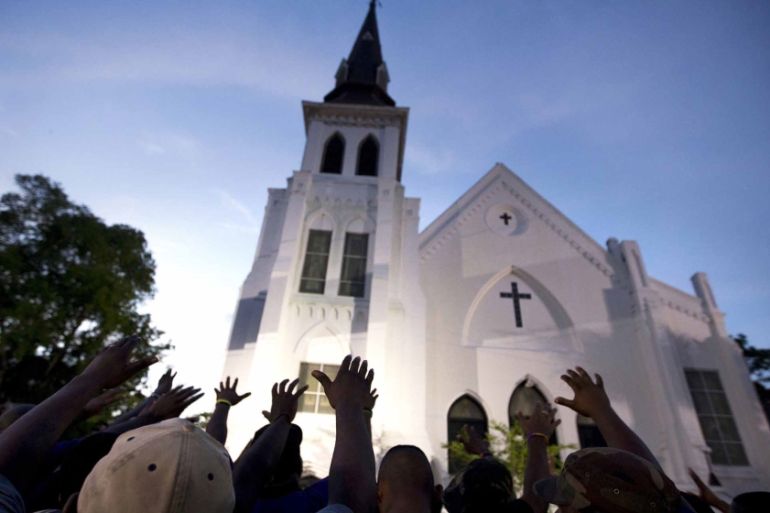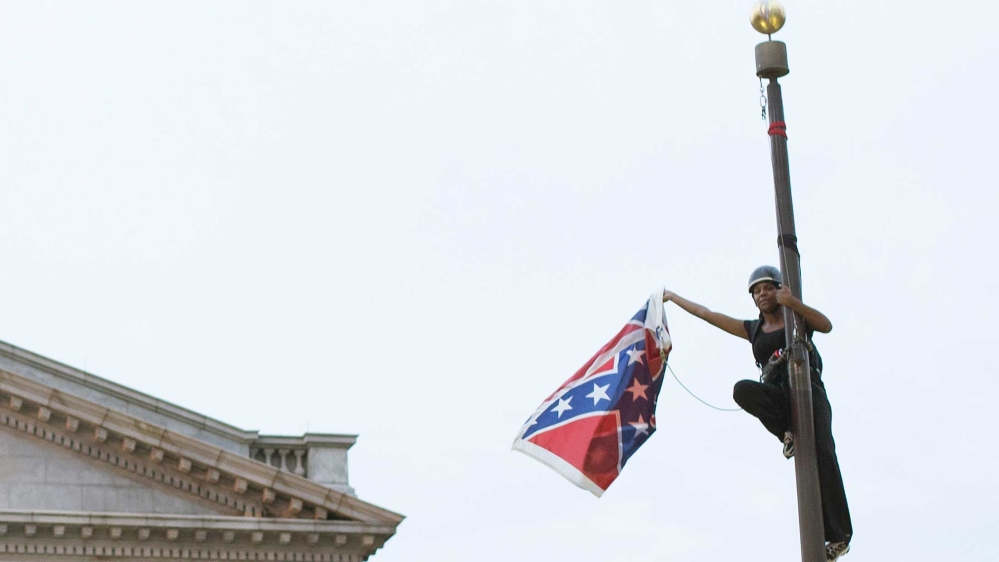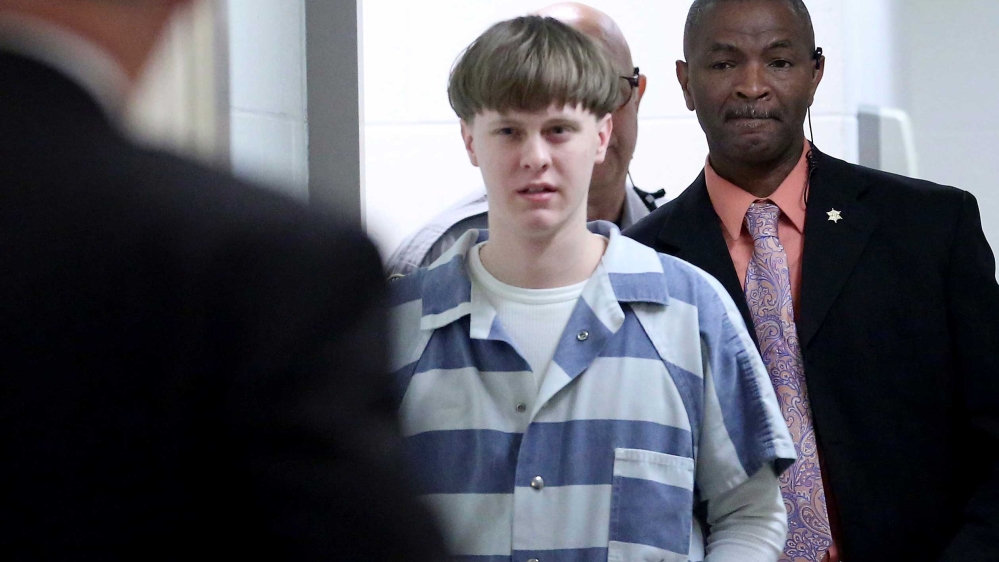Charleston church massacre: 5 years on Confederate debate rages
Dylann Roof sat through an hour of Bible study at a church before shooting nine Black worshippers in 2015.

Five years ago, after nine Black church members and their pastor were shot dead in a racist attack, South Carolina banded together and took down the Confederate flag from the state Capitol lawn in Columbia after years of angry debate on the topic.
Today, as yet another shocking killing of an African American roils the country, prompting protesters to pull down statues associated with past racism and demand the removal of names of historical figures who repressed or oppressed other people, South Carolina leaders appear to be sitting out the current movement so far.
Keep reading
list of 4 items‘Feel less and less like playing’: Vinicius Jr in tears over racist abuse
‘Rendered invisible’: A wave of anti-Arab violence tests US hate crime laws
Germany bans far-right Austrian nationalist Martin Sellner from entry
Dylann Roof sat through nearly an hour of Bible study at the Mother Emanuel AME church and then started shooting as the group prayed. Nine Black worshippers were killed. Roof spared one woman’s life so she could tell everyone he wanted to start a race war. He was sentenced to death and remains in federal prison.
Roof did not hesitate to explain his racist beliefs to FBI agents and left a handwritten journal full of his views, such as Black people being inferior to whites. He also left behind pictures of himself holding the gun used in the killings, posing at historic Civil War and African American sites and holding the Confederate flag.
Today we remember the nine lives lost at Charleston’s Emanuel AME Church in a hatred-driven attack. As we mourn this loss, we must take action. When racism and guns mix, the results are catastrophic, and we cannot afford to lose more Black lives to this preventable epidemic. pic.twitter.com/1tN2q4Cz5n
— Rep. Eric Swalwell (@RepSwalwell) June 17, 2020
Outraged political leaders in South Carolina – former Republican Governor Nikki Haley among them – came together and overwhelmingly voted to take down a Confederate flag that flew near a monument to Confederate soldiers on the Statehouse lawn.
It was the last time the South Carolina General Assembly invoked a 2000 law called the Heritage Act that protects historical monuments and names of buildings in the state unless a two-thirds majority of state legislators in the General Assembly vote to allow the changes.

The hurdle is a high one in a state where conservative Republicans dominate the state House and Senate, one made even harder by Republican House Speaker Jay Lucas’s promise in the days after the Confederate flag came down in 2015 that he would never consider another change like it while he led the House.
Lucas has kept his word.
The pressure is mounting, however. Clemson University trustees voted last Friday to ask the General Assembly to let it change the name of Tillman Hall, a main building on campus named for “Pitchfork” Ben Tillman.
Tillman gained notoriety for supporting a white mob that killed four Black men in 1876 after they surrendered to them. He later became South Carolina’s governor and a US senator, committed to destroying any rights Black people obtained after the Civil War.
“We of the South have never recognised the right of the negro to govern white men, and we never will. We have never believed him to be equal to the white man, and we will not submit to his gratifying his lust on our wives and daughters without lynching him,” Tillman said in a 1900 congressional speech.
Rooting out white supremacy
Just weeks after Roof stormed the church, activist Brittany “Bree” Newsome Bass scaled the 9.2-metre tall flagpole outside South Carolina’s statehouse and removed the Confederate flag. Footage of the incident was broadcast on news programmes across the country. She was arrested and the flag was put back on its pole.
Since then, the debate has led to a slew of legislation from legislators on both sides, demonstrations, and the toppling of monuments and erection of new ones.
“I think the taking down of monuments and symbology, specifically, is also about challenging this idea that white property and state property is more valuable than our lives,” Newsome Bass told Democracy Now on Wednesday.
The debates continue, Newsome said, because the ideology of the Confederacy and white supremacy remains mainstream.
“We have to dig deeper in really understanding what it means to uproot and root out white supremacist ideology as we go through this process of renaming things and changing symbols,” she said.

Mayor of the historic city of Charleston, John Tecklenburg announced Wednesday that the city plans to remove a statue of slavery advocate John C. Calhoun from a downtown square.
In the past week, NASCAR banned the Confederate flag from its events and races, and the Marine Corps banned public displays of the Confederate flag from its military installations. In Virginia, protesters took down a statue of Jefferson Davis, the president of the Confederacy.
The president of the University of South Carolina has said he wants lawmakers to let the school remove the name of J Marion Sims from a women’s dorm. Sims is honoured as the father of modern gynaecology, but conducted experimental treatment on slaves without anaesthesia.
Sims and Tillman also have statues on the statehouse lawn. Some African American legislators want plaques added, explaining their racist views. Others, like Representative Justin Bamberg, want Tillman and the others gone.
“I don’t like seeing ‘Pitchfork’ Ben Tillman every dang day I go to the statehouse,” the Democrat said. “He boldly and proudly supported lynching my people.”
And in Charleston on Tuesday, the current pastor of Mother Emanuel stood with civil rights activists and politicians calling for the removal from a downtown park of a 30-metre-tall (100 feet) statue of former US Vice President John C Calhoun.
Calhoun’s support of slavery never wavered. And in an 1836 speech before the US Senate, he said slaves in the South were better off than free Black people in the North.
The Reverend Nelson Rivers said Calhoun “represents Dylann Roof to us” and said Charleston leaders should defy the unjust Heritage Act – which does not include penalties for breaking it – and remove the statue.
“The time has come to not just acknowledge your racist evil wicked past. The time has come to take down the monuments that honour the evil that was done in the name of Charleston, in the name of South Carolina,” Rivers said on Tuesday at the foot of Calhoun’s statue.
Charleston Mayor John Tecklenburg said he will announce the city’s decision on Wednesday on the statue’s future.
The time has come for Republicans in South Carolina to either clear the way to remove monuments or show their true colours, said Rivers, who spent nearly 40 years with the NAACP and is now a vice president with the civil rights group National Action Network.
“Either you support a monument to hate or you do not,” Rivers said. “There is nothing fuzzy about this.”